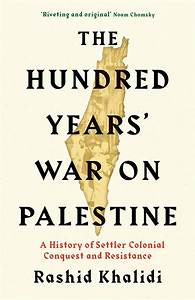The 100 Years' War on Palestine
The Hundred Years’ War on Palestine: A History of Settler Colonial Conquest and Resistance
By Rashid Khalidi
Profile Books Ltd (2024)
Book Review
Authored by the son of a negotiator in the 1990s Madrid and Oslo negotiations, Khaidi organizes his book as as a series of six wars against Palestinian Arabs, the first dating 1917-1939.* Although he’s is highly critical of British and (and later US) foreign policy for systematically denying Palestinians any right of self-determination, he’s also highly critical of other Arab states (who have a long history of denying self-government to their own subjects) and Yasser Arafat and other PLO leaders for denying Palestinian residents of input into the Madrid and Oslo peace negotiations.*
The book also contains an Afterword about Israel’s current war on Gaza, with has mobilized support for Palestine, throughout the Western and Arab world, as well as the global South. At present, Khalidi estimates that approximately 5 million Palestinians live in Israel and its occupied Palestinian territories and 5 million live in exile.
The most interesting parts sections the book concern the Israeli invasion of Lebanon In 1982 (Khalidi and his young family lived in Beirut at the time) and the peace negotiations (in which his father served as an advisor to Palestinian negotiators) leading to the 1993 Oslo Accord.
1909: Khalidi starts his chronology in 1909, when Palestine was stil a colony of the Ottoman Empire. At the time the first Jewish immigrants (fleeing brutal repression in Eastern Europe) arrive (40,000 in 1909-1914), Jews represent 6% of the population and Jews, Arabs and Christians lived comfortably side by side.
1917: The Balfour Declaration, signaling British intent to establish a Jewish state in British- controlled Palestine, issued on November 2, 1917.
1936-38: Palestine remains a British colony until 1947, subject to brutal military repression when they protest eviction by Jewish immigrants from the farmland they work. Because European Jews fleeing Nazi persecution are denied entry to the to the UK and and US, many flee to Palestine, where the Jewish population increases to 18%. An armed rebellion in 1936 lasted two years it could only be quashed by massive military force.
1947-48: Ongoing terrorist attacks by Jewish paramilitary groups (Stern Gang, Haganah, Irgun) force the British to withdraw from Israel in 1947, leaving the newly created United Nations in charge of Palestine and the formal process of independence. The original UN resolution grants 56% of historic Palestine to the self-governing state of Israel (despite Jews representing a minority of Israel’s population) and 44% Palestinian Arab state tsubject to military occupation by the king of Jordan.
Jewish paramilitary groups begin ethnically cleansing many Arab-assigned sectors of Palestine prior to 1947, a process that evicts 300,000 Arabs from Palestine’s major cities prior to the UN-designated date for Israeli independence (May 15, 1948) and 400,000 shortly afterwards. They flee to Jordan, Syria, Lebanon, the West Bank (then under Jordanian control) and Gaza (then controlled by Egypt).
Palestinian refugees with means, skills or relatives in Arab countries (a large majority) come to live outside refugee camps.**
1959: Fatah (the party which currently runs the Palestinian Authority) formed in Kuwait 1959 by group of Palestinian engineers, teachers and professionals headed by Arafat.
1964: Because the Arab states fear retaliation by Israel, they oppose Palestinian attacks on Israeli border regions, and the Arab League forms the PLO (in Egypt) in the hope of reigning in Fatah. Meanwhile the Egyptian and Jordanian military harass, arrest and torture Gaza militants who stage attacks on Israel.
1967: Following Israel’s 1967 Six Day War war on Egypt, Jordan and Syria, Egypt and Jordan are forced to withdraw from Gaza and the West Bank, which have been Israeli colonies every since.
1969: the Cairo Agreement puts the PLO in charge of security in the Lebanese refugee camps and by the start of the Lebanese Civil War (1973-1990), the PLO (with 15,000 15,000 armed members) represents the largest military force in many parts of Lebanon.
1982: Israel invades Lebanon and embarks on seven week siege of Beirut. They make withdrawal of all PLO troops a condition for ending the siege. They latter resettle in numerous Arab capitols, with the PLO leadership in Tunis.
1987: indirectly empowered by the PLO’s political decline, a secret Unified National leadership launches the First Intifada, consisting of mainly peaceful strikes, boycotts, demonstrations, and subject to brutal Israeli military repression.
1993: first Oslo Accord signed, negotiated mainly by PLO leaders with no direct knowledge of actual conditions in the West Bank and Gaza. Creates the Palestinian Authority, which has limited political input into any aspects of governance other than security, and takes over from Israel the task persecuting, arresting and torturing Palestinian militants. Conditions become much worse for everyone but a few Palestinian authority leaders.
1994: Arafat returns to Palestine
2000: Worsening repression leads to Second Intifada, resulting in Arafat’s imprisonment in his compound until his death (most likely by polonium poisoning) in 2004.
2005: Abbas elected to 4 year term as president.
2006: After boycotting the 2005 election, Hamas win 74 seats to Fatah’s 45 seats in the Palestinian Authority legislature. Refusing to accept Hamas as part of the PA government, a US trained Fatah-controlled security force invades Gaza and makes an unsuccessful attempt to unseat Hamas.
*For most of his life, Arafat ran the PLO in exile from Lebanon or Tunis. He only resided in Palestine for 10 years (1994-2004).
**Breakdown by country:
In Jordan, of 2.2 million originally registered with UNRWA, only 370,000 remain in camp today (The king of Jordan granted Jordanian citizenship to all Palestinian and they now represent the majority of Jordan’s population.)
In the West Bank only 1/4 of the 830,000 registered with UNRWA remain in camps.
In Syria, only 1/4 of the 550,000 refugees remain in camps
In Lebanon, fewer than half the 470,000 refugees remain in camps.



